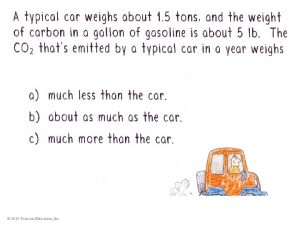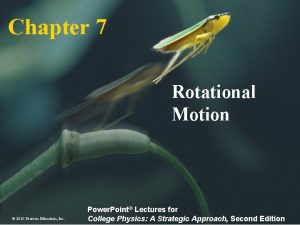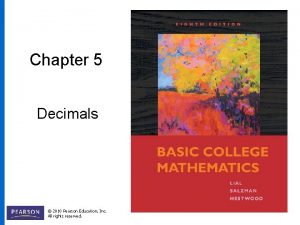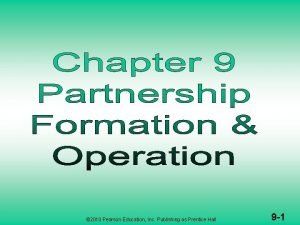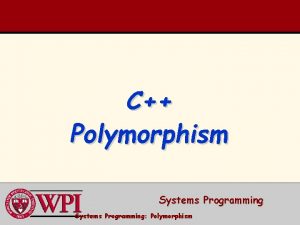AN INTRODUCTION TO POLYMORPHISM 2010 Pearson AddisonWesley All















- Slides: 15

AN INTRODUCTION TO POLYMORPHISM © 2010 Pearson Addison-Wesley. All rights reserved.

Preventing a Method from Being Overridden • The final modifier will prevent the overriding of a superclass method in a subclass. public final void message() • If a subclass attempts to override a final method, the compiler generates an error. • This ensures that a particular superclass method is used by subclasses rather than a modified version of it. © 2010 Pearson Addison-Wesley. All rights reserved. 11 -2

Visibility Revisited • Private/Public • UML - = private, + = public • Block visibility • Static/non. Static © 2010 Pearson Addison-Wesley. All rights reserved.

Protected Members • Protected members of class: – may be accessed by methods in a subclass, and – by methods in the same package as the class. • Java provides a third access specification, protected. • A protected member’s access is somewhere between private and public. • UML = # • Example: – Graded. Activity 2. java – Final. Exam 2. java – Protected. Demo. java © 2010 Pearson Addison-Wesley. All rights reserved. 11 -4

Protected Members • Using protected instead of private makes some tasks easier. • However, any class that is derived from the class, or is in the same package, has unrestricted access to the protected member. • It is always better to make all fields private and then provide public methods for accessing those fields. • If no access specifier for a class member is provided, the class member is given package access by default. • Any method in the same package may access the member. © 2010 Pearson Addison-Wesley. All rights reserved. 11 -5

Access Specifiers Access Modifier Accessible to a subclass inside the same package? Accessible to all other classes inside the same package? default (no modifier) Yes Public Yes Protected Yes Private No No Accessible to a subclass outside the package? Access Modifier Accessible to all other classes outside the package? default (no modifier) No No Public Yes Protected Yes No Private No No © 2010 Pearson Addison-Wesley. All rights reserved. 11 -6

Chains of Inheritance • A superclass can also be derived from another class. Object Example: Graded. Activity. java Pass. Fail. Exam. Demo. java Graded. Activity Pass. Fail. Exam © 2010 Pearson Addison-Wesley. All rights reserved. 11 -7

Chains of Inheritance • Classes often are depicted graphically in a class hierarchy. • A class hierarchy shows the inheritance relationships between classes. Graded. Activity Final. Exam Pass. Fail. Activity Pass. Fail. Exam © 2010 Pearson Addison-Wesley. All rights reserved. 11 -8

The Object Class • All Java classes are directly or indirectly derived from a class named Object. • Object is in the java. lang package. • Any class that does not specify the extends keyword is automatically derived from the Object class. public class My. Class { // This class is derived from Object. } • Ultimately, every class is derived from the Object class. © 2010 Pearson Addison-Wesley. All rights reserved. 11 -9

The Object Class • Because every class is directly or indirectly derived from the Object class: – every class inherits the Object class’s members. • example: to. String and equals. • In the Object class, the to. String method returns a string containing the object’s class name and a hash of its memory address. • The equals method accepts the address of an object as its argument and returns true if it is the same as the calling object’s address. • Example: Object. Methods. java © 2010 Pearson Addison-Wesley. All rights reserved. 11 -10

Poly – many morph – form ism • A reference variable can reference objects of classes that are derived from the variable’s class. Graded. Activity exam; • We can use the exam variable to reference a Graded. Activity object. exam = new Graded. Activity(); • The Graded. Activity class is also used as the superclass for the Final. Exam class. • An object of the Final. Exam class is a Graded. Activity object. © 2010 Pearson Addison-Wesley. All rights reserved. 11 -11

Polymorphism • A Graded. Activity variable can be used to reference a Final. Exam object. Graded. Activity exam = new Final. Exam(50, 7); • This statement creates a Final. Exam object and stores the object’s address in the exam variable. • This is an example of polymorphism. • The term polymorphism means the ability to take many forms. • In Java, a reference variable is polymorphic because it can reference objects of types different from its own, as long as those types are subclasses of its type. © 2010 Pearson Addison-Wesley. All rights reserved. 11 -12

Polymorphism • Other legal polymorphic references: Graded. Activity exam 1 = new Final. Exam(50, 7); Graded. Activity exam 2 = new Pass. Fail. Activity(70); Graded. Activity exam 3 = new Pass. Fail. Exam(100, 10, 70); • The Graded. Activity class has three methods: set. Score, get. Score, and get. Grade. • A Graded. Activity variable can be used to call only those three methods. Graded. Activity exam = new Pass. Fail. Exam(100, 10, 70); System. out. println(exam. get. Score()); // This works. System. out. println(exam. get. Grade()); // This works. System. out. println(exam. get. Points. Each()); // ERROR! © 2010 Pearson Addison-Wesley. All rights reserved. 11 -13

Polymorphism and Dynamic Binding • If the object of the subclass has overridden a method in the superclass: – If the variable makes a call to that method the subclass’s version of the method will be run. Graded. Activity exam = new Pass. Fail. Activity(60); exam. set. Score(70); System. out. println(exam. get. Grade()); • Java performs dynamic binding or late binding when a variable contains a polymorphic reference. • The Java Virtual Machine determines at runtime which method to call, depending on the type of object that the variable references. © 2010 Pearson Addison-Wesley. All rights reserved. 11 -14

Polymorphism • It is the object’s type, rather than the reference type, that determines which method is called. • Example: – Polymorphic. java • You cannot assign a superclass object to a subclass reference variable. © 2010 Pearson Addison-Wesley. All rights reserved. 11 -15
 2010 pearson education inc
2010 pearson education inc 2010 pearson education inc
2010 pearson education inc 2010 pearson education inc answers
2010 pearson education inc answers 2010 pearson education inc answers
2010 pearson education inc answers 2010 pearson education inc answers
2010 pearson education inc answers 2010 pearson education inc answers
2010 pearson education inc answers 2010 pearson education inc
2010 pearson education inc 2010 pearson education inc
2010 pearson education inc Copyright 2010 pearson education inc
Copyright 2010 pearson education inc 2010 pearson education inc
2010 pearson education inc Copyright 2010 pearson education inc
Copyright 2010 pearson education inc The four forces shown have the same strength
The four forces shown have the same strength Pearson education inc 5
Pearson education inc 5 2010 pearson education inc
2010 pearson education inc Pearson education 2010
Pearson education 2010 2010 pearson education inc
2010 pearson education inc



